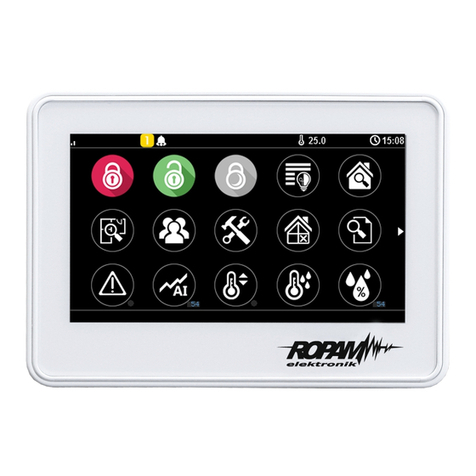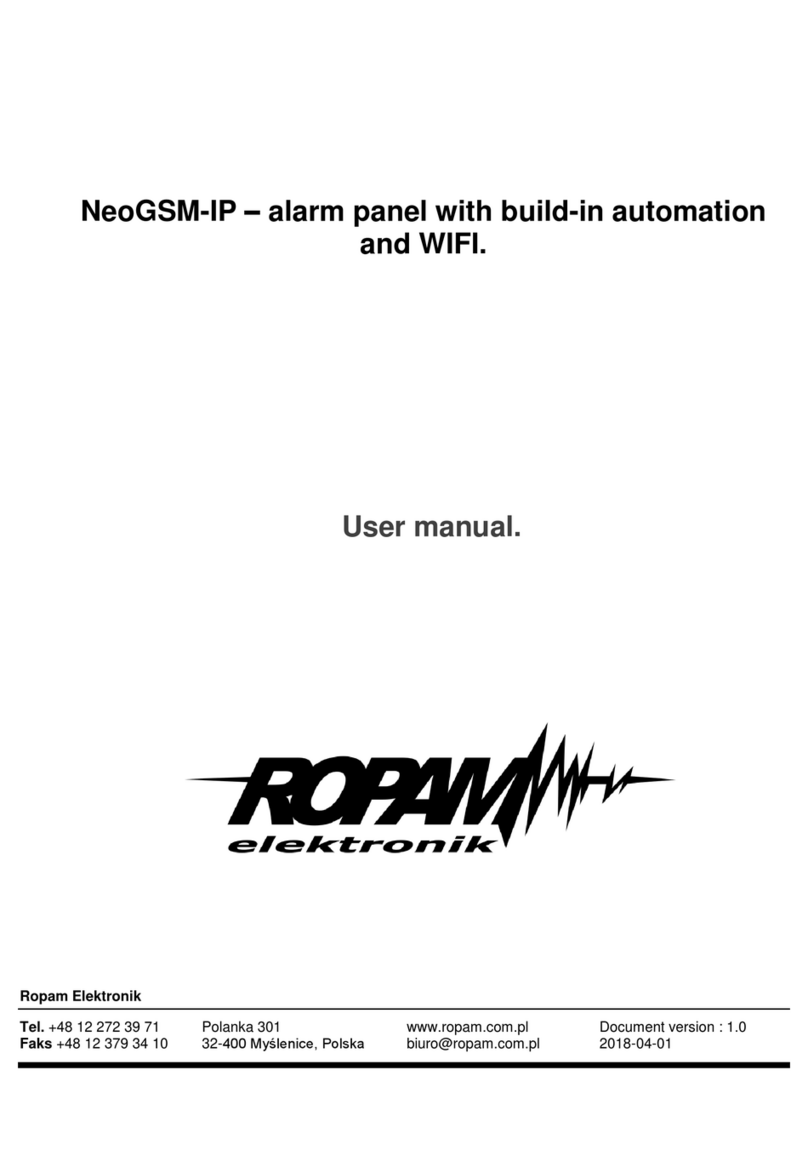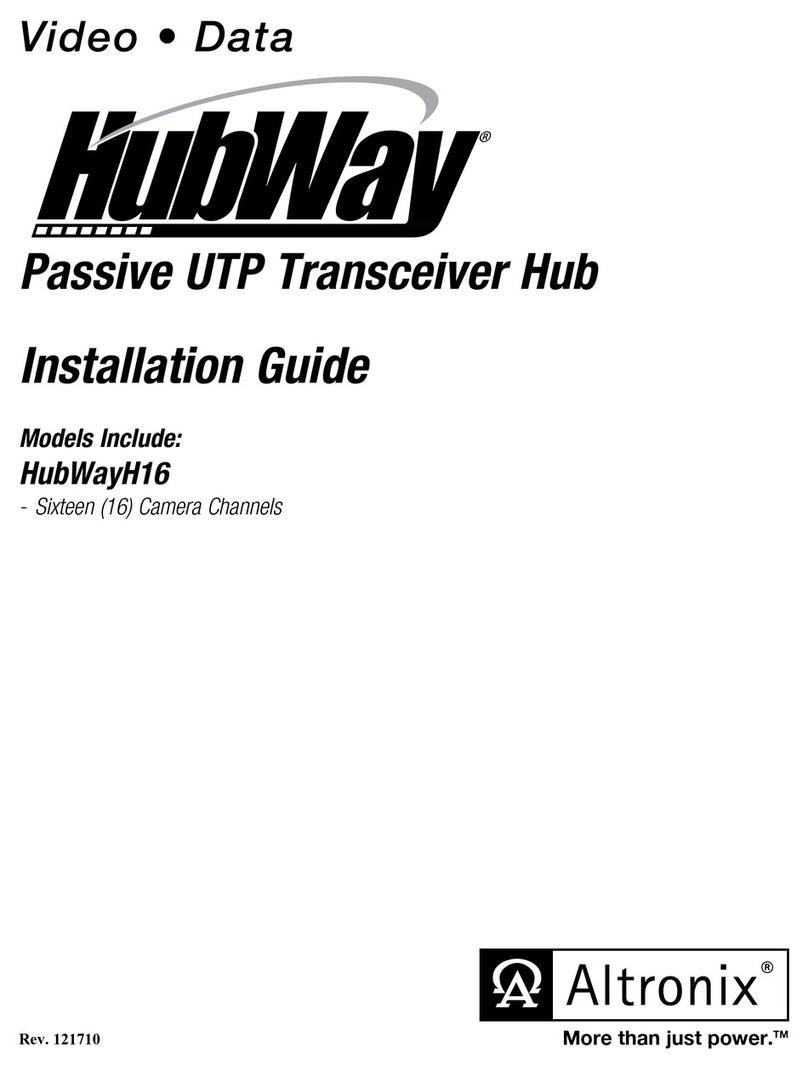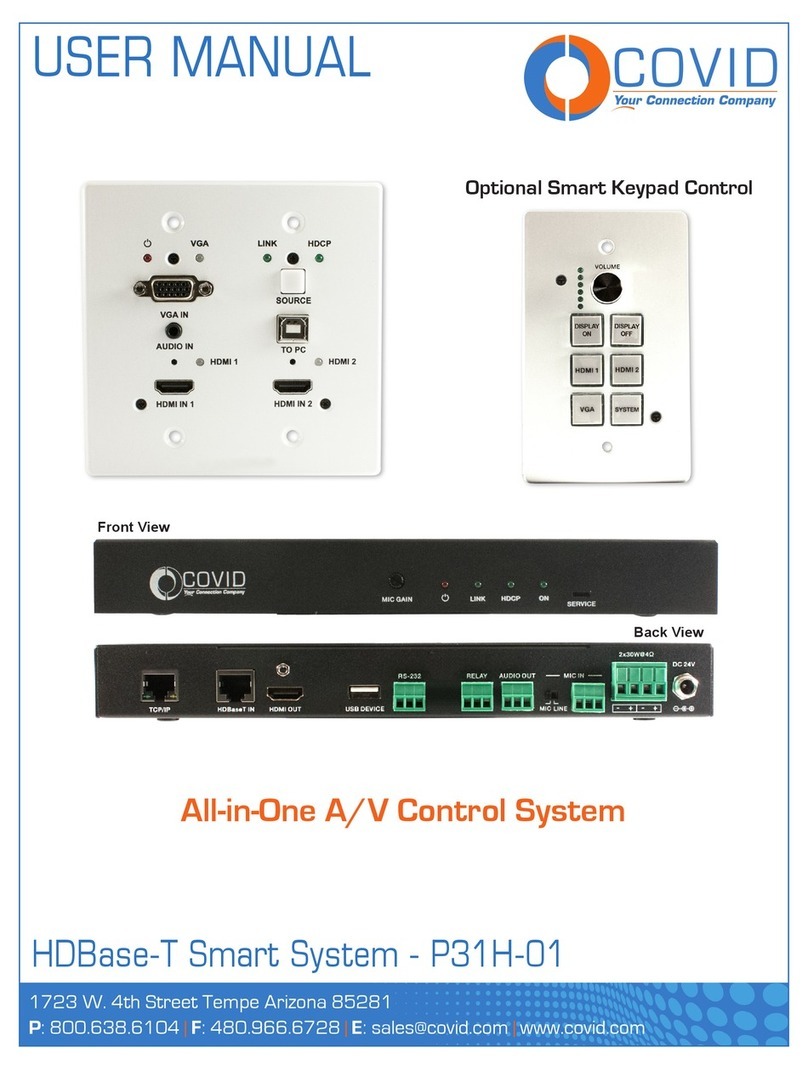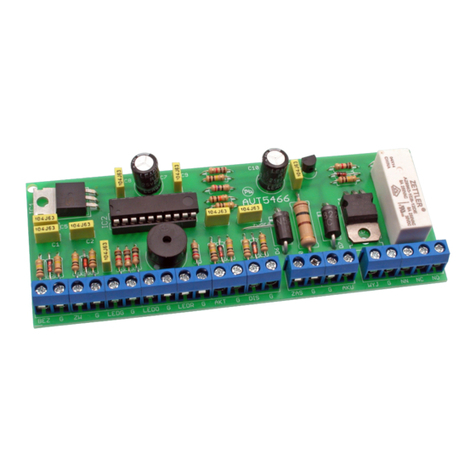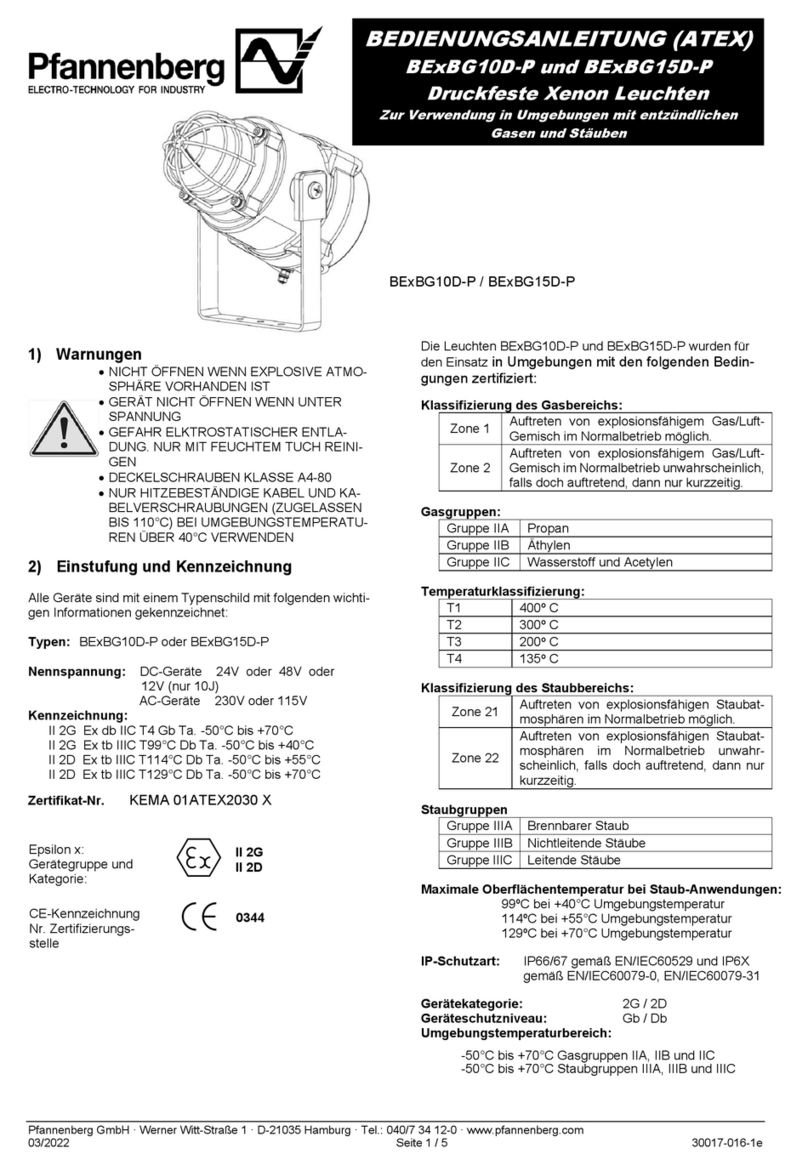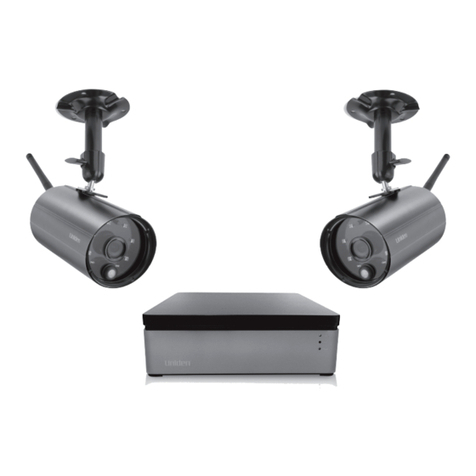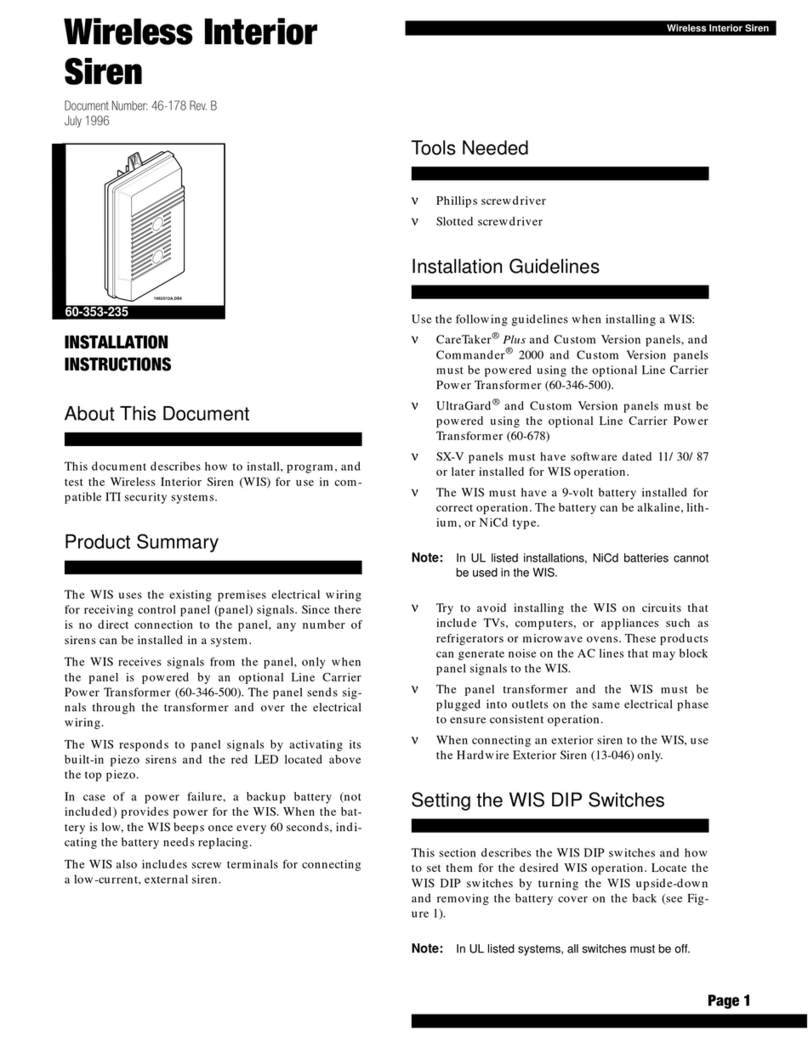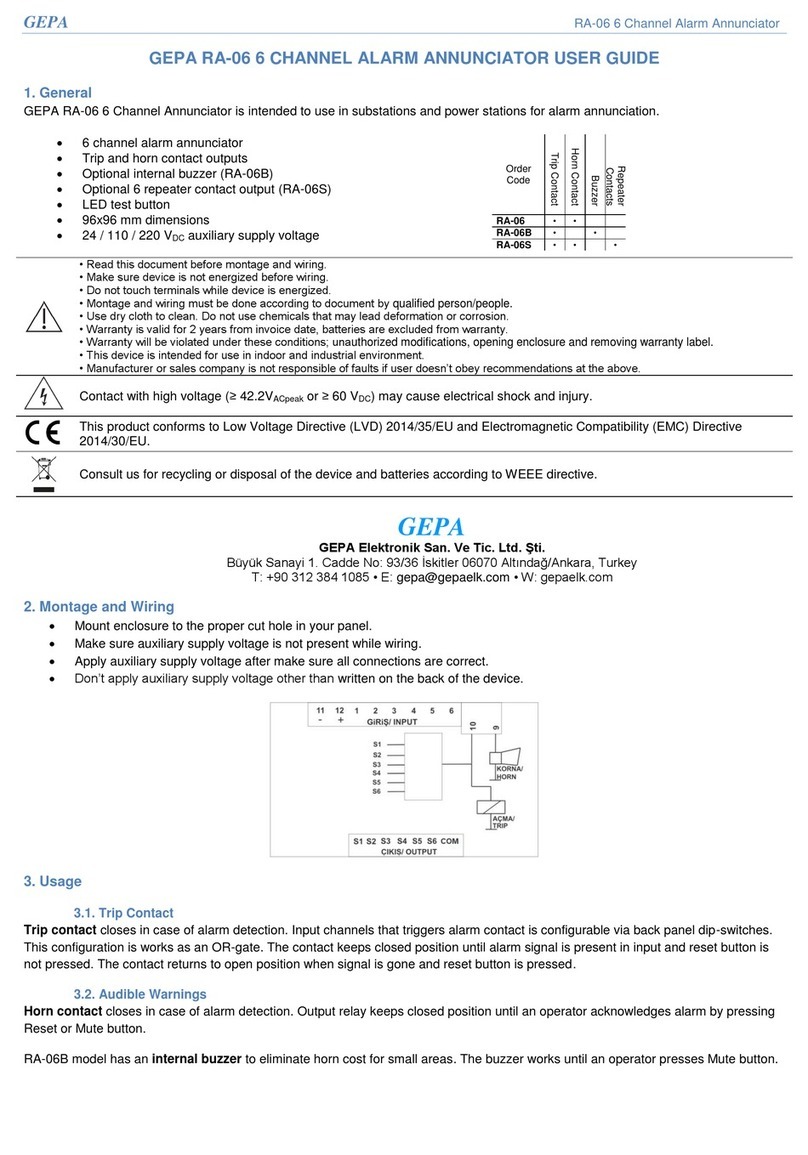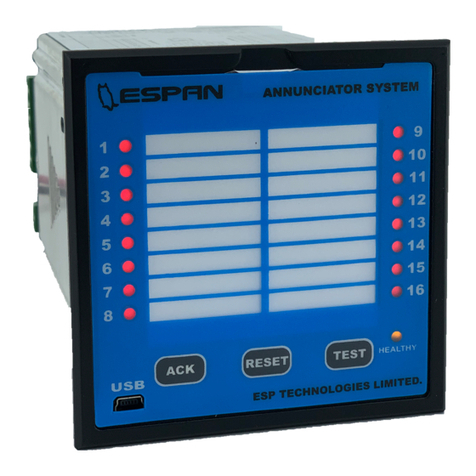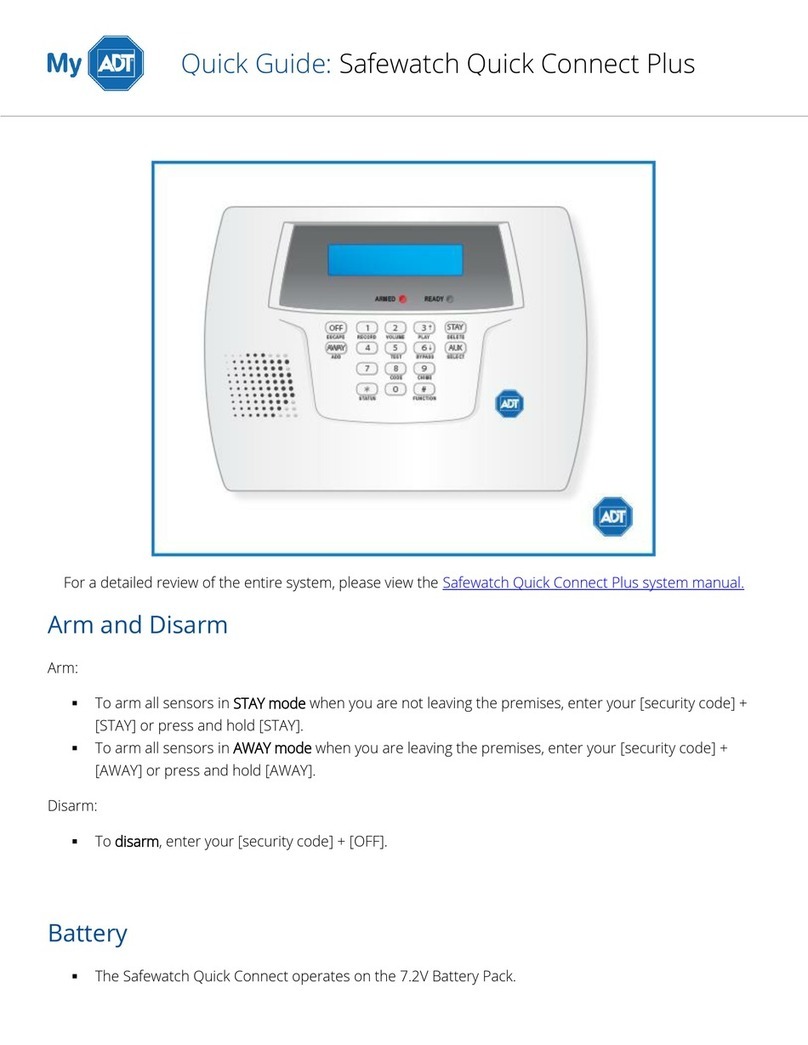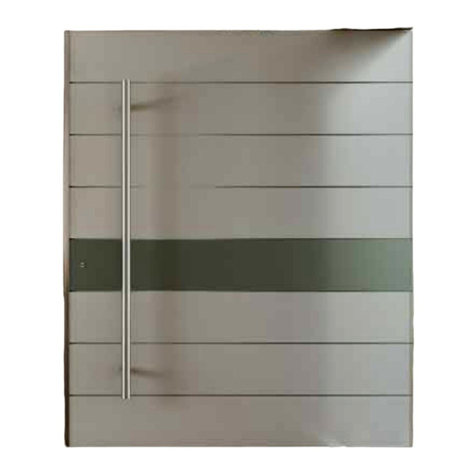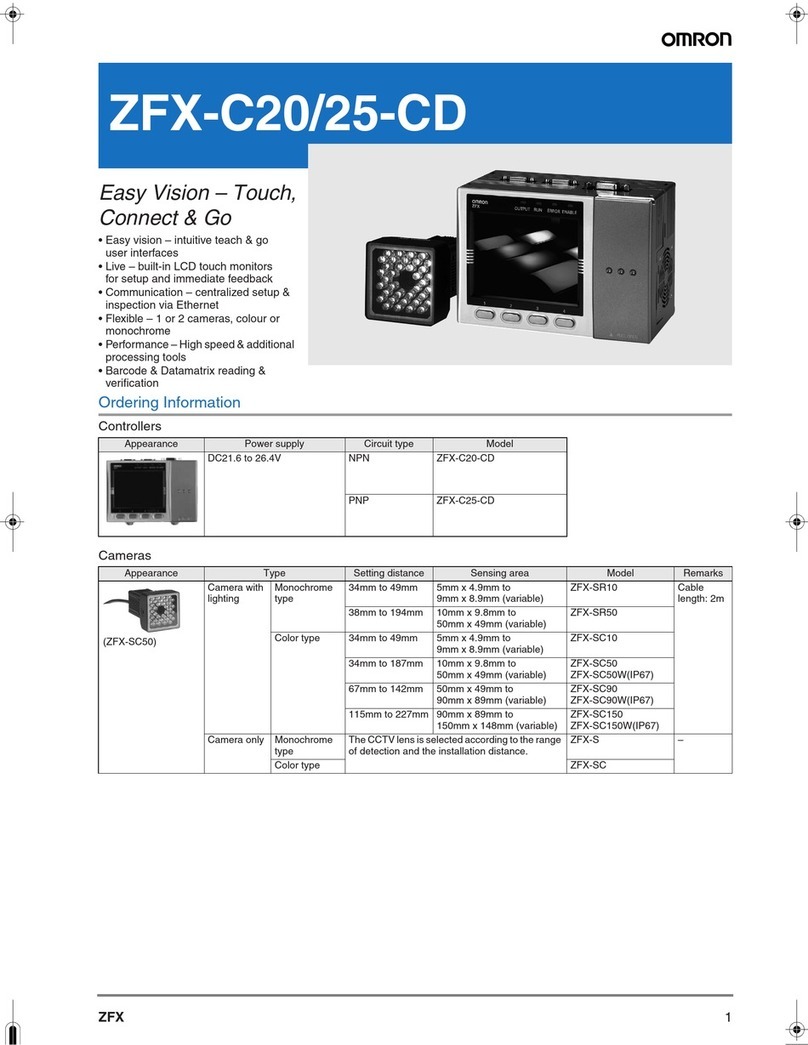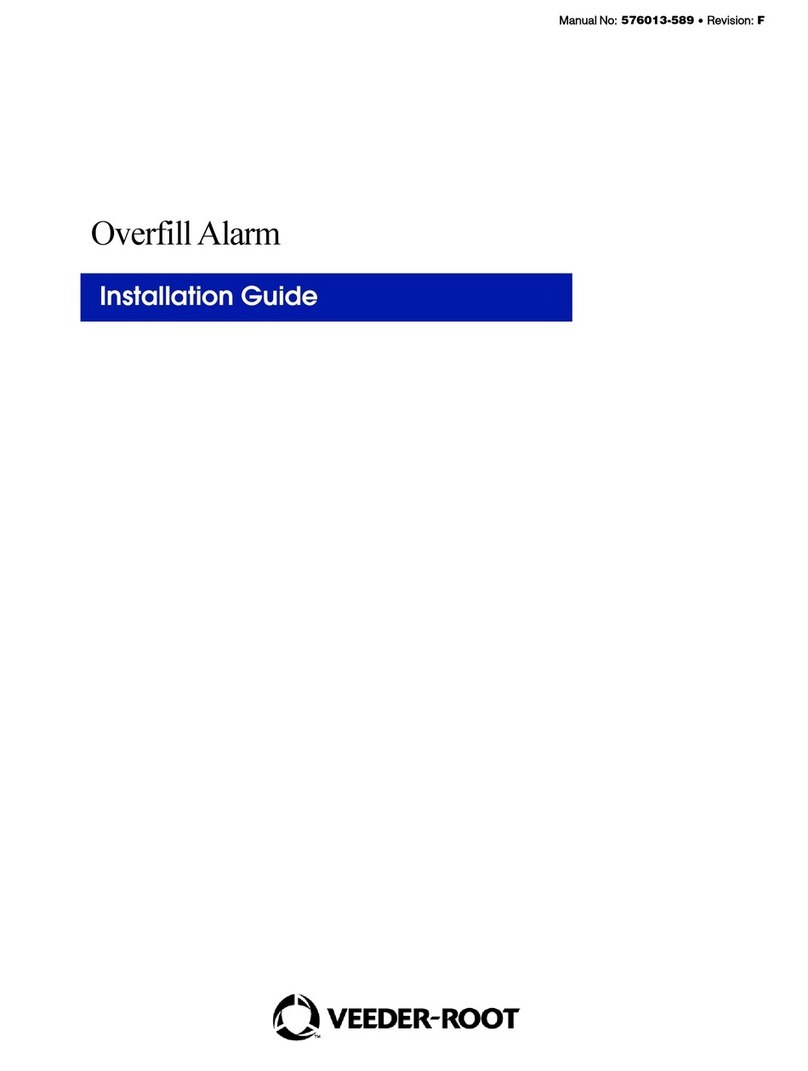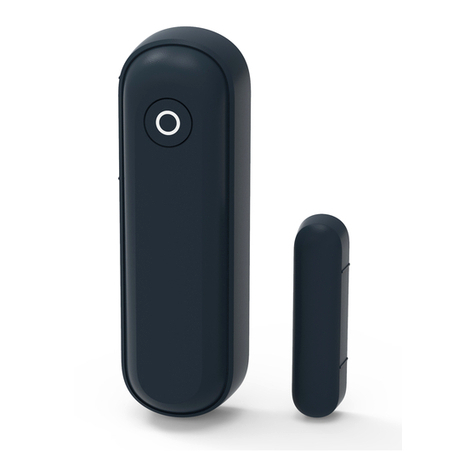Ropam elektronik OptimaGSM Series User manual

OptimaGSM –alarm system withGSM
communication and building automation.
Ropam Elektronik
Tel. +48 12 272 39 71
Faks +48 12 379 34 10
Polanka 301
32-400 Myślenice, Polska
https://www.ropam.com.pl/en
biuro@ropam.com.pl
Document version : 1.0
2017-10-06
Installation Guide (DTR).

© 2017 Ropam Elektronik
WARNINGS
For safety reasons, this equipment should be installed only by qualified personnel.
Before proceeding with the installation, refer to the above instruction, the connection
must be performed without the power supply.
Do not power on the unit without connecting an external antenna (starting the device
without the antenna connected may damage the phone transmissions and void the
warranty!).
Do not interfere with construction or carry out repairs yourself.
Protect your electronics against electrostatic discharges.
In order to meet LVD and EMC requirements, the following must be observed: power,
installation, shielding - according to application. The device is a source of
electromagnetic waves, so it may interfere with other radio devices in specific
configurations.
Ropam Elektronik is not responsible for any malfunction of the GSM network and any
possible technical problems.
WEEE LABELING
Waste electrical and electronic equipment must not be disposed of with household
waste. According to the WEEE directive (EU Directive 2002/96 / EC), electrical and
electronic equipment used should be used separately. In Poland, it is prohibited to place
together with other wastes of worn equipment marked with a crossed-out wheeled bin
symbol in accordance with the regulations on waste electrical and electronic equipment.
The user who intends to dispose of this product is obliged to give the above mentioned.
to the point of collection of used equipment. Collection points are conducted, among
others. by the wholesale and retail sellers of this equipment and the municipal
organizational units engaged in waste collection activities. The correct implementation
of these obligations is particularly important in the case of hazardous equipment that has
a negative impact on the environment and human health.
The power supply unit is compatible with a 12V DC lead acid battery (SLA, VRL). It
should not be discarded after use, but must be disposed of in accordance with the
applicable regulations.
(European Union Directives 91/157 / EEC and 93/86 / EEC).

© 2017 Ropam Elektronik
Table of Contents
1. General description.................................................................................................................... 1
Properties........................................................................................................................................ 1
Appliance. ....................................................................................................................................... 2
Warnings......................................................................................................................................... 3
Requirements for SMS and RopamDroid, DTMF control. .............................................................. 3
2. System description...................................................................................................................... 4
Description of the device................................................................................................................. 4
Device versions........................................................................................................................... 4
Description of connectors and elements..................................................................................... 5
Optical signaling of the state....................................................................................................... 7
Additional modules and extensions. ............................................................................................... 9
AP-IP......................................................................................................................................... 10
General description................................................................................................................ 10
Properties........................................................................................................................... 10
Warnings............................................................................................................................ 11
Description of the module...................................................................................................... 11
Construction and description ............................................................................................. 11
Assembly and installation...................................................................................................... 13
Basic requirements. ........................................................................................................... 13
Connection and start-up of the AP-IP module. .................................................................. 13
Configuration. ........................................................................................................................ 15
Configuration: OptimaGSM Manager................................................................................. 16
Configuration and status control: SMS. ............................................................................. 18
System configuration: TCP / IP AP-IP module. ................................................................. 19
Advanced configuration of the router................................................................................. 21
Providing a fixed IP address......................................................................................... 22
System maintenance. ............................................................................................................ 24
Technical parameters............................................................................................................ 24
Version history....................................................................................................................... 25
EXP-I8-RN................................................................................................................................. 25
General description................................................................................................................ 25
Properties........................................................................................................................... 25
Destiny. .............................................................................................................................. 26

© 2017 Ropam Elektronik
Warnings............................................................................................................................ 26
Description of the module...................................................................................................... 26
Module versions................................................................................................................. 26
Construction and description. ............................................................................................ 26
Optical signaling of the state.............................................................................................. 27
Requirements, installation. .................................................................................................... 27
Basic requirements. ........................................................................................................... 27
Installation and connection of the module.......................................................................... 28
Technical parameters............................................................................................................ 29
Version history....................................................................................................................... 29
EXP-O8T-RN............................................................................................................................. 30
General description................................................................................................................ 30
Properties........................................................................................................................... 30
Destiny. .............................................................................................................................. 30
Warnings............................................................................................................................ 30
Description of the module...................................................................................................... 30
Module versions................................................................................................................. 30
Construction and description. ............................................................................................ 31
Optical signaling of the state.............................................................................................. 32
Requirements, installation. .................................................................................................... 32
Basic requirements. ........................................................................................................... 32
Installation and connection of the module.......................................................................... 32
System maintenance. ............................................................................................................ 33
Technical parameters............................................................................................................ 33
Version history....................................................................................................................... 33
EXP-O8R-RN ............................................................................................................................ 34
General description................................................................................................................ 34
Properties........................................................................................................................... 34
Destiny. .............................................................................................................................. 34
Warnings............................................................................................................................ 34
Description of the module...................................................................................................... 34
Module versions................................................................................................................. 34
Construction and description. ............................................................................................ 35
Optical signaling of the state.............................................................................................. 36
Requirements, installation. .................................................................................................... 36

© 2017 Ropam Elektronik
Basic requirements. ........................................................................................................... 36
Installation and connection of the module.......................................................................... 36
System maintenance. ............................................................................................................ 37
Technical parameters............................................................................................................ 37
Version history....................................................................................................................... 38
APm-AERO ............................................................................................................................... 38
General description................................................................................................................ 38
Properties........................................................................................................................... 38
Destiny. .............................................................................................................................. 38
Warnings............................................................................................................................ 39
Controller description............................................................................................................. 39
Controller versions. ............................................................................................................ 39
Construction and description. ............................................................................................ 39
Assembly and installation...................................................................................................... 39
Basic requirements. ........................................................................................................... 39
Installing the controller....................................................................................................... 40
Configuration. ........................................................................................................................ 40
Configuration: Partner GSM / OptimaGSM Manager. ....................................................... 40
OptimaGSM Manager: AP-Aero................................................................................... 40
Technical parameters............................................................................................................ 44
Version history....................................................................................................................... 45
Keyfob-AERO............................................................................................................................ 45
General description................................................................................................................ 45
Properties........................................................................................................................... 45
Destiny. .............................................................................................................................. 45
Warnings............................................................................................................................ 45
Pilot description. .................................................................................................................... 46
Remote control versions. ................................................................................................... 46
Construction and description. ............................................................................................ 46
Requirements, installation. .................................................................................................... 47
Basic requirements. ........................................................................................................... 47
Installing the controller....................................................................................................... 47
Configuration. ........................................................................................................................ 47
Preparing the system for work........................................................................................... 47
Configuration: Partner GSM / OptimaGSM Manager._6 ................................................... 49

© 2017 Ropam Elektronik
OptimaGSM Manager: AP-Aero................................................................................... 49
Flags for the pilot in Logic Processor. .......................................................................... 51
Technical parameters............................................................................................................ 52
Version history....................................................................................................................... 52
IO-AERO ................................................................................................................................... 52
General description................................................................................................................ 52
Properties........................................................................................................................... 52
Destiny. .............................................................................................................................. 53
Warnings............................................................................................................................ 53
Description of the module...................................................................................................... 53
Versions of the IO-Aero module......................................................................................... 53
Construction and description. ............................................................................................ 54
Assembly and installation...................................................................................................... 54
Basic requirements. ........................................................................................................... 54
Description and operation of the IO-Aero module. ............................................................ 55
Installation and programming of the IO module................................................................. 55
Reset procedure for lips factory......................................................................................... 56
Configuration. ........................................................................................................................ 56
Configuration: Partner GSM / OptimaGSM Manager. ....................................................... 56
OptimaGSM Manager: AP-Aero................................................................................... 56
System maintenance. ............................................................................................................ 58
Technical parameters............................................................................................................ 59
Version history....................................................................................................................... 59
TPR-4........................................................................................................................................ 59
General description................................................................................................................ 59
Properties........................................................................................................................... 59
Destiny ............................................................................................................................... 60
Warnings............................................................................................................................ 60
Description of the touch panel............................................................................................... 60
Construction of the TPR-4 touch panel.............................................................................. 61
Description of connectors and elements. ..................................................................... 61
View and dimensioning of the panel............................................................................. 62
Installation and commissioning.............................................................................................. 62
Basic requirements. ........................................................................................................... 62
System cabling................................................................................................................... 63
Panel connection................................................................................................................ 64

© 2017 Ropam Elektronik
Installation and start-up procedure TPR-4......................................................................... 64
Configuration of TPR-4 touch panels. ................................................................................... 65
TPR-4 configuration: user menu........................................................................................ 66
Set the clock ................................................................................................................. 66
Relay time..................................................................................................................... 66
Turn on Gong................................................................................................................ 67
Reading an SMS........................................................................................................... 67
Brightness of the screensaver...................................................................................... 67
Service access.............................................................................................................. 67
Thermostats.................................................................................................................. 67
Room thermostats ........................................................................................................ 68
Timers 1-4..................................................................................................................... 72
USSD codes, test SMS................................................................................................. 74
Entering the USSD code ............................................................................74
Send the USSD code to the GSM network.................................................74
Send a test SMS ........................................................................................74
Internet module............................................................................................................. 74
Show network status..................................................................................75
SSID:..........................................................................................................75
WPA:..........................................................................................................75
Module restart............................................................................................75
Remote programming................................................................................................... 75
TPR-4 configuration: service menu.................................................................................... 76
Settings 1...................................................................................................................... 77
TPR-4 configuration: OptimaGSM Manager...................................................................... 77
Tab: touch panel / settings. .......................................................................................... 79
Tab: touch panel / display options................................................................................ 80
Tab: Editing screens..................................................................................................... 81
Icon descriptions and functions.................................................................................... 82
Firmware update.................................................................................................................... 86
TPR-4 software update procedure..................................................................................... 87
TPR-4 panel maintenance..................................................................................................... 87
Technical parameters. TPR-4................................................................................................ 88
Version history....................................................................................................................... 89
RHT-AERO................................................................................................................................ 89
General description................................................................................................................ 89
Properties........................................................................................................................... 89
Destiny ............................................................................................................................... 89
Warnings............................................................................................................................ 89

© 2017 Ropam Elektronik
Description of the module...................................................................................................... 90
Module versions................................................................................................................. 90
Construction and description. ............................................................................................ 90
Assembly and installation...................................................................................................... 91
Basic requirements. ........................................................................................................... 91
Description and operation of the RHT-Aero module.......................................................... 91
Installation and programming of the RHT-Aero module. 8 ................................................ 91
RHT-Aero flags in Logic Processor.................................................................................... 92
Configuration. ........................................................................................................................ 93
Preparing the system for work........................................................................................... 93
Power connection / ext. sensor for the module.................................................................. 93
Configuration: OptimaGSM Manager................................................................................. 93
OptimaGSM Manager: APx-Aero - temperature / humidity detectors. 5...................... 94
Value display settings on the TPR-4 panel. 5 .............................................................. 94
System maintenance. ............................................................................................................ 95
Technical parameters............................................................................................................ 95
Version history....................................................................................................................... 96
VAR-1U ..................................................................................................................................... 96
General description................................................................................................................ 96
Properties........................................................................................................................... 96
Destiny ............................................................................................................................... 96
Warnings............................................................................................................................ 96
Description of the module...................................................................................................... 97
Construction and description. ............................................................................................ 97
Module versions................................................................................................................. 98
Requirements, installation. .................................................................................................... 98
Basic requirements ............................................................................................................ 98
Installation.............................................................................................................................. 98
Preparing the system for work........................................................................................... 98
Connecting the module to the control panel. ..................................................................... 99
List of devices cooperating with the module...................................................................... 99
Connection of the entry phone to VAR-1U ...................................................................... 100
Configuration.................................................................................................................... 100
OptimaGSM Manager: VAR-1U ................................................................................. 100
Changing the parameters of the module.................................................................... 101
Custom settings.......................................................................................................... 102

© 2017 Ropam Elektronik
Downloading a photo from the video door phone....................................................... 102
Bolt control using DTMF............................................................................................. 103
Switching bolt...........................................................................................104
SMS command for control of bolt............................................................................... 104
System maintenance. .......................................................................................................... 104
Technical parameters.......................................................................................................... 104
Version history..................................................................................................................... 105
3. Installation and commissioning. .............................................................................................. 106
Basic requirements. .................................................................................................................... 106
Wiring the system. ...................................................................................................................... 106
Connection of the RopamNET bus............................................................................................. 107
Connecting devices to inputs...................................................................................................... 109
Connecting devices to the outputs.............................................................................................. 110
Connecting the signal to the AI input.......................................................................................... 113
Connection of temperature sensors............................................................................................ 113
Connection of a speech synthesizer, audio module................................................................... 113
Connecting the IQPLC system.................................................................................................... 114
Connection of the AP-IP communication module....................................................................... 115
Connecting the power supply to control panel............................................................................ 117
Installation and start-up procedure. ............................................................................................ 117
The procedure for a reset to factory settings.............................................................................. 119
4. System configuration............................................................................................................... 120
System configuration: OptimaGSM Manager. ............................................................................ 120
Description of the program toolbar.......................................................................................... 120
Local configuration via COM port............................................................................................ 120
Remote configuration: TCP / IP (GPRS)................................................................................. 121
System configuration: TCP / IP AP-IP module........................................................................ 122
Firmware upgrade. .................................................................................................................. 123
Functional description. ............................................................................................................ 123
Tab: SIM card settings......................................................................................................... 123
Tab: Zones, phone numbers, e-mail address...................................................................... 124
Tab: Modules, TPR panels.................................................................................................. 124
Touchpad. ........................................................................................................................ 124
EXP-I8 expander.............................................................................................................. 125
APx-Aero.......................................................................................................................... 125
PSR-ECO-xx.................................................................................................................... 127

© 2017 Ropam Elektronik
Hub-IQPLC-D4M.............................................................................................................. 127
FGR-4 MMS..................................................................................................................... 131
RF-4. ................................................................................................................................ 132
EXP-I8-RN. ...................................................................................................................... 133
EXP-O8x-RN (EXP-O8R-RN or EXP-O8T-RN)............................................................... 133
AP-IP................................................................................................................................ 134
Tab: Inputs........................................................................................................................... 134
Tab: Inputs - notification................................................................................................... 136
Tab: Inputs - options. ....................................................................................................... 136
Tab: Outputs........................................................................................................................ 137
Tab: Outputs - notifications.............................................................................................. 139
Tab: LogicProcessor............................................................................................................ 139
Logic functions. ................................................................................................................ 141
Time relays....................................................................................................................... 152
Starting values. ................................................................................................................ 156
Preview of the script......................................................................................................... 158
Simulator.......................................................................................................................... 158
Application notes.............................................................................................................. 159
Tab: Timers.......................................................................................................................... 159
Tab: Communication, tests, counters.................................................................................. 159
Tab: System options............................................................................................................ 160
Tab: Analog input................................................................................................................. 161
Tab: Temperature................................................................................................................ 162
Tab: Room thermostats....................................................................................................... 163
Tab: online........................................................................................................................... 163
Netmonitor GSM (BTS).................................................................................................... 165
Tab: events.......................................................................................................................... 167
5. System operation. ................................................................................................................... 168
Basic SMS commands................................................................................................................ 168
Basic DTMF commands.............................................................................................................. 170
RopamDroid application.............................................................................................................. 171
RopamOptima application........................................................................................................... 171
Launching................................................................................................................................ 172
Configuration........................................................................................................................... 173
System demo .......................................................................................................................... 175

© 2017 Ropam Elektronik
6. SMTP settings for GPRS and IP............................................................................................. 177
Sample e-mail accounts.............................................................................................................. 177
Set up an e-mail account, OptimaGSM Manager....................................................................... 178
Prioritizing sending messages.................................................................................................... 179
Email notifications about events. ................................................................................................ 179
Errors - sending an e-mail........................................................................................................... 181
7. System maintenance............................................................................................................... 183
8. Technical parameters.............................................................................................................. 184
9. Version history......................................................................................................................... 186
10. Information........................................................................................................................... 189

Page 01
General description.
© 2017 Ropam Elektronik
1. General description.
Thank you for choosing Ropam Elektronik products and solutions. We hope that our equipment will
meet your requirements and will serve you reliably for years to come. Ropam Elektronik continues to
innovate its products and solutions. With the update function products can be enriched with new
features and keep up with the modern requirements for the protection of property systems and home
automation. We invite you to visit our website www.ropam.com.pl for information on current versions.
If you have any additional questions, please contact us by phone or email.
Properties.
The OptimaGSM alarm control panel with peripheral devices is a solution that integrates the
electronic burglary signaling system and building automation using the SmartPLC technology. Built-in
GSM communicator allows to remote monitoring and controling of the system. Thanks to the modular
design, the system can be expanded and adapted to changing needs of the user.
The control panel has unique functions compared to competing products and is the most functional
system on the market in its class, including:
- building automation functions using communication on the electric network, unique SmartPLC
technology,
- the ability to control using the RopamDroid application for Android smatrfones,
- flexible control of the armed mode: touch panels, SMS, system input, radio remote controls
(RF-4), in accordance with the requirements of current installations: 'from the shell to the
residence',
- support of touch panels; surface-mounted version TRP-1-O, TPR-2W-O, TPR-2B-O and
concealed TPR-1F-O, TPR-4W, TPR-4B
- visual verification of the object's status: FGR-4 module for sending MMS / E-MAIL messages
with photos from industrial cameras,
- VSR-2 speech synthesizer, allowing you to send 16 voice messages containing unique
information about the event (VOICE) or VSR-1, allowing you to send a voice message
(VOICE),
- AMR-1 audio module (microphone), allowing for eavesdropping of the object and audio
verification,
- VAR-1 gateway and FGR-4 module for integration with a video intercom, integration allows for
a telephone conversation between a door station and a mobile phone as well as sending
pictures in the MMS format,
- integration of audio intercoms and intercoms,
- temperature sensors for controlling and recording temperature and thermostat function,
- RF-4 radio controller for controlling the armed mode and outputs (4) through radio remote
controls,
- PSR-ECO power supply system for large systems and in case of working in variable
temperatures in order to properly service the battery,
- analog input AI 0-10V for checking physical parameters, eg battery voltage, humidity [% RH],
temperature, etc.

Page 02
General description.
© 2017 Ropam Elektronik
SmartPLC technology integrates the OptimaGSM system with distributed "smart connectors".
Communication between the control panel and the concentrator is based on the RopamNET bus.
SmartPLC while the communication between the concentrator and intelligent connector is carried out
after the power supply lines of low-voltage buildings installations. SmartPLC is a unique and innovative
approach to communication, transforming electrical installations of building into a communication bus
for control and monitoring. SmartPLC technology from Ropam Elektronik opens a new chapter in
building automation and gives so far unavailable options for designers and integrators.
Appliance.
The alarm system built on the basis of the OptimaGSM series alarm panels, TPR-xx touch panels and
other additional devices is an ideal solution for residential buildings and small commercial facilities.
Modern design, proven technology of the touch panel with a spectacular color LCD display is ideal for
composing in most interiors and rooms. The intuitive and clear interface makes the control of the alarm
system has never been as easy as with TPR-xx. The touch panel in combination with the control panel
allows you to build a fully functional alarm system.
The OptimaGSM system also allows you to create simple home automation applications with remote
control via SMS / CLIP and Wifi / Ethernet.
Flexible functions also allow use in systems that use binary signal control, temperature, visual
verification is required and information transfer is based on SMS, VOICE, MMS, e-mail.
• building automation systems integrated with the OptimaGSM system,
• smart home, home automation,
•electronic intrusion detection systems,
• Remote control and monitoring of electrical equipment,
• intelligent lighting,

Page 03
General description.
© 2017 Ropam Elektronik
Warnings.
Ropam Elektronik devices are part of a full alarm system, whose working effectiveness depends on
the quality and technical condition of all devices (detectors, signaling devices), cabling, etc. included
in the system. The user is obliged to periodically test the operation of the alarm system. It is
necessary to check whether the control panel reacts to the violation of individual detectors (PIR, reed
switches, etc.) or signaling devices (external and internal) and notifications. The detailed method of
system control is determined by the installer that the system has designed. Periodic system
maintenance is recommended (with device status check, back-up power supply, system operation,
messaging, etc.).
Ropam Elektronik is not responsible for the correct operation of operators and GSM network
infrastructure used for alarm and remote control messages. It is advisable to use a GSM operator that
guarantees min. Two BTSs of the given system location with GSM communication. In addition, we
recommend using such services and subscriptions available on the market that guarantee correct
operation (human factor minimization, eg blocked outgoing calls due to lack of funds in the account,
allow for full configuration of the GSM track (for example, disable advertising services).
We do not recommend using national roaming operators!
In addition, it should be noted that the services guaranteed by GSM operators are voice services
(VOICE) rather than SMS, so important information should be transmitted via voice calls and the
exact identification of the event takes place in the SMS (eg VOICE + SMS, CLIP + SMS).
For service like e-mail transmission it is recommended to create a independent e-mail account (eg.
Alarm@domena.pl) in a proven provider e-mail accounts. Sharing of data to an SMTP server from a
private account can result in unauthorized access to these accounts.
Requirements for SMS and RopamDroid, DTMF control.
To service via SMS and RopamDroid mobile phone, the smartphone must encode SMS: GSM or
UNICODE alphabet, other formats are not supported!
For the RopamDroid application, the smartphone must have compatible SMS support with the
Android API and not have overlays, other SMS interception apps that have priority for the inbox or
outbox.
For proper setup and operation of RopamBasic it is required to have adequate knowledge of system
configuration and data (service):
- knowledge of the phone number of the SIM card installed in the system,
- knowledge of "SMS password / application login password" and active option: "Possible remote
programming via GPRS",
- knowledge of the encryption key TCP / IP.
- control via the RopamBasic requires the setting triggered by the "Mobile Application" for the output,
- for controlling the GSM thermostat, it is necessary to start the function of temperature measurement
and thermostat.
To control the DTMF phone, the smartphone must be able to generate DTMF tones during a phone
call.
A single DTMF code (pressing the sign) should last for a minimum of 0.5s.

Page 04
System description.
© 2017 Ropam Elektronik
2. System description.
Description of the device.
Device versions.
Code
Description
OptimaGSM
Alarm control panel with GSM communication and building automation
functions:
SMS / VOICE / CLIP / GPRS / MMS / E-MAIL, 12VDC *, PSR-ECO x1,
TELx8, BIx8-48, BOx8-32, AI, TEMPx4, Aero x16, IQPLC x8, PCB,
GPRS monitoring, ThermostatGSM, KeyGSM, LoggerTemp.
LogicProcessor.
(* to power required supervised, intelligent, system power supply: PSR-
ECO-5012-RS)
OptimaGSM-D9M
Alarm control panel with GSM communication and building automation
functions:
SMS / VOICE / CLIP / GPRS / MMS / E-MAIL, 12VDC *, PSR-ECO x1,
TELx8, BIx8-48, BOx8-32, AI, TEMPx4, Aero x16, IQPLC x8, housing
DIN 9M
GPRS monitoring, ThermostatGSM, KeyGSM, LoggerTemp.
LogicProcessor.
(* to power required supervised, intelligent, system power supply: PSR-
ECO-5012-RS)
OptimaGSM-PS
Alarm control panel with GSM communication and building automation
functions:
SMS / VOICE / CLIP / GPRS / MMS / E-MAIL, 17VAC / 24VDC, buffer
power supply 12V / 2A, TELx8, BIx8-48, BOx8-32, AI, TEMPx4, Aero x16,
IQPLC x8, PCB
GPRS monitoring, ThermostatGSM, KeyGSM, LoggerTemp.
LogicProcessor
OptimaGSM-PS-D9M
Alarm control panel with GSM communication and building automation
functions:
SMS / VOICE / CLIP / GPRS / MMS / E-MAIL, 17VAC / 24VDC, power
supply buf. 12V / 2A, TELx8, BIx8-48, BOx8-32, AI, TEMPx4, Aero x16,
IQPLC x8, DIN 9M housing
GPRS monitoring, ThermostatGSM, KeyGSM, LoggerTemp.
LogicProcessor

Page 05
System description.
© 2017 Ropam Elektronik
Description of connectors and elements.

Page 06
System description.
© 2017 Ropam Elektronik
View: OptimaGSM PCB.
Connector / element
Description / Function
+V -
power terminals
OptimaGSM = 9÷14V/DC
OptimaGSM-PS = 16÷20V/AC or 20÷30V/DC *
X1
connector for connecting the PSR-ECO-5012-RS power supply; power
supply and RopamNET (only OptimaGSM)
O1÷O2
controlled transistor outputs, high-current 12V / 1A,
second load terminal: GND,
(control of the continuity of the circuit, connection of the signaling device)
O3÷O8
controlled transistor outputs, OpenCollector (OC, GND / 0.1A)
second load terminal: AUX (+ 12V)
I1÷I8
control panel inputs, programmed configuration: NO, NC, EOL, DEOL /
NC, DEOL / NO, second GND input terminal
AI
analog control panel input, 0-10V, software scaling to any physical value
(eg temp = ° C, RH =%)
GND (x8)
the "ground" terminal of the control panel, common for power supply, bus
and inputs
AUX (x2)
power output for 12V / DC devices (12VDC / 1A) eg motion detectors,
second GND power terminal
O3÷O8
controlled outputs OpenCollector (OC, GND / 0,1A) second terminal load
AUX / + KB (+ 12V)
+KB
power output for 12V / DC devices, dedicated to power touch panels
(12VDC / 1A)
A
B
RopamNET system bus connector (EIA-485),
connection principle A-A, B-B, GND-GND
DO1÷DO8
LED diodes indicating the status of O1 ÷ O8 outputs
JT1
jumper for terminating the RopamNET bus (EIA 485)
jumper on = terminating resistor on (120 Ohm)
jumper removed = terminating terminating resistor (HiZ)
PR
jumper for running software updates via RS232TTL
SIMCARD
connector (slot) for mounting the SIM card (vertical)
+ BAT -
12V battery connection connector (emergency power supply):
+ BAT (red) = '+' battery
- BAT (black) = '-' battery
(only OptimaGSM-PS)
X3
connector for connecting the LCD panel (local display),
MODEM GSM
modem, industrial phone GSM / DCS / EGSM

Page 07
System description.
© 2017 Ropam Elektronik
H-FME
antenna connector in the holder, FME-M output, for connecting the GSM
antenna
RS232TTL
RJ12 socket for connecting a service computer, used for programming
local or firmware updates
(RS232-MGSM or USB-MGSM cable required)
VSR
connector for connecting: VSR-2, VSR-1 voice synthesizer or AMR-1
audio module or VAR-1 gateway
EXP
communication interface for additional (local) modules
FGR-4 - video processing module for MMS
T1-T4
GND
+VT
connector for connecting temperature sensors of the TSR-1-xx series
(T1-T4 connector addresses the number of the sensor / thermostat in the
system),
the supply of temperature sensors must be connected to the connectors:
+ VT-GND
X2
connector for connecting the EXP-I8 zone expander (local)
COMM
GREEN LED indicates communication with the GSM modem
SEND
YELLOW LED signaling SMS sending or voice connection (in
communication mode with computer)
LOG
BLUE LED indicates the GSM network level
FAIL
The RED LED indicates a fault
(exchange of firmware in programming mode)
INCOM
YELLOW LED indicates reception of a call or text message
AC/DC
GREEN LED indicates the primary and emergency power supply
Optical signaling of the state.
The control panel is equipped with optical signaling of states. There are LEDs on the PCD board that
determine the operating status: messaging, communication with the PC, software version upgrade.
LED
COLOR
SIGNALING STATE
NORMAL
SIGNALING THE
PROGRAMMING STATE
COMM
GREEN
• short flashes every 1s =
correct communication with the GSM
modem
• alternating blinking (wave);
COMM-SEND-LOG-FAIL =
change of firmware in the
control panel (active
communication)
SEND
Yellow
• sending SMS and voice notification,
notification action is carried out in
accordance with the scheme:
NOTIFICATION by SMS
-1 flash = sending SMS to NUMBER 1, ...
8 flashes = sending SMS to NUMBER 8,
• it blinks every 1s. =
connection to a service
computer
• blinking alternately SEND
and INCOM = restoring
copies of settings from

Page 08
System description.
© 2017 Ropam Elektronik
VOICE NOTIFICATION - 1 flash =
connection to NUMBER 1, ... 8 flashes =
connection to NUMBER 8,
EEPROM (configuration
error checksum)
• alternating blinking (wave);
COMM-SEND-LOG-FAIL =
change of firmware in the
control panel (active
communication)
LOG
BLUE
• a series of short flashes from 1 to 5
every approx. 2s =
GSM network level status (1-min 5-max)
• no flashing = phone not logged in to the
GSM network
• alternating blinking (wave);
COMM-SEND-LOG-FAIL =
change of firmware in the
control panel (active
communication)
FAIL
RED
• status of the failure, the failure code is
synonymous with the number of blinks
FAIL diodes on the control panel board
(series):
01 - low level network below 2 "dashes"
(RSSI <15)
02 - modem not logged in to the GSM
network
03 - unsuccessful sending of SMSes in the
series
04 - no connection to the GPRS
monitoring station (ARC)
05 - no GPRS
06 - no communication with the GSM
modem
07 - PIN code error (PUK lock)
08 - SIM error, no SIM
09 - required PIN card not logged in
10 - GSM jamming (jamming)
11 - no AC
12 - overload / short circuit of O1 output
13 - O2 overload / short circuit
14 - no load on the O1 output
15 - no load of the O2 output
16 - overloading / shorting of the AUX
output
17 - overload / shorting of the output + KB
18 - low DC power supply voltage (<11V)
19 - failure / lack of battery (<11V)
20 - EEPROM memory error
21 - overload / short circuit of the + VT
output
22 - modem power failure
23 - FLASH memory error (serial)
24 - RTC clock chip error
25 - failure of the motherboard inputs
26 - internal error of the MCU
microcontroller
27 - blocking SMS / CALL / MMS / E-
MAIL, exceeding 24h counter
• alternating blinking (wave);
COMM-SEND-LOG-FAIL =
change of firmware in the
control panel (active
communication)
• blinking simultaneously
with the INCOM LED every
approx. 1s - service mode

Page 09
System description.
© 2017 Ropam Elektronik
28 - loss of connection with the IQPLC
device
INCOM
YELLOW
• no light = no incoming calls to the
control panel number
• shines = incoming call, CSD or SMS to
the control panel number
• shines = CSD modem
connection to a remote
computer
• blinking alternately SEND
and INCOM = restoring
copies of settings from
EEPROM (configuration
error checksum)
• blinking simultaneously
with the FAIL diode every
approx. 1s - service mode
AC/DC
GREEN
• lit = main power present 17V / AC or
24V / DC
• blinks = lack of basic power supply,
battery supply,
Additional modules and extensions.
CODE
Max.
value
in the
system
Description
TPR-xx
4**
Touch panel TPR-xx (surface mounted), TPR-1F (concealed) is a modern element of
control and monitoring of the alarm system.- TPR-1x touch panel, modern keyboard
for system control in TPR-1 and TPR-1F surface-mounted version, made of INOX
steel,- TPR-2x touch panel, modern keyboard for system control in a white or
graphite surface version, made of ABS plastic,
FGR-4
1
The FGR-4 module is an innovative and universal device for cooperation with alarm
control panels. It allows you to process four video signals into images in the 'jpg'
format and send them via multimedia messages via MMS / email. The solution is
based on standard services of GSM operators and does not require any special
devices and software. The universal functions and design of the FGR-4 module
makes it possible to use it to control the state of the object, visual verification of
alarm events, eg sending a picture from the object after the burglary, fire alarm and
unauthorized entry.
TSR-1-
xx
4
Digital temperature sensor, with a measuring range of -20 ° C to + 70 ° C or -55 to +
125 ° C.
VSR-2
1*
The module for recording and reproduction of 16 audio messages (8x 16sec + 8x
8sec), additionally allows you to connect the audio module to listen to the object.
MGSM 4.0+ allows the aggregation of independent messages from several (5)
recordings in case of violation, entry tampering.
VSR-1
1*
Module for recording and playback 20 seconds of voice message.
AMR-1
1*
The audio module allows you to eavesdrop on an object's audio: during an alarm or
after making a voice call.
This manual suits for next models
4
Table of contents
Other Ropam elektronik Security System manuals
